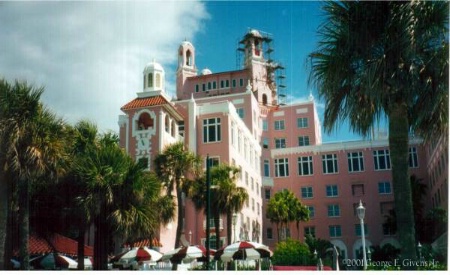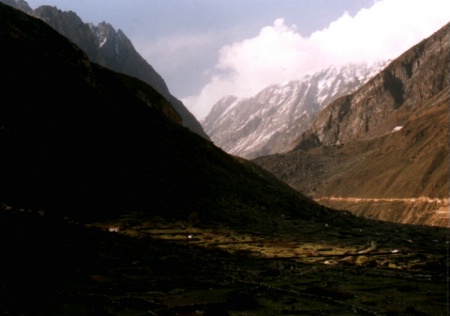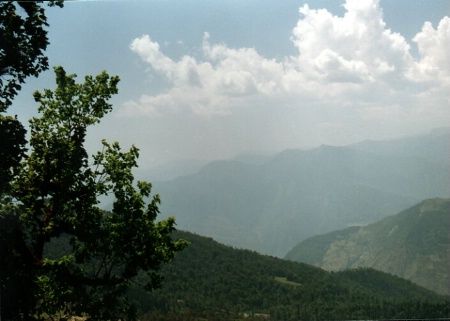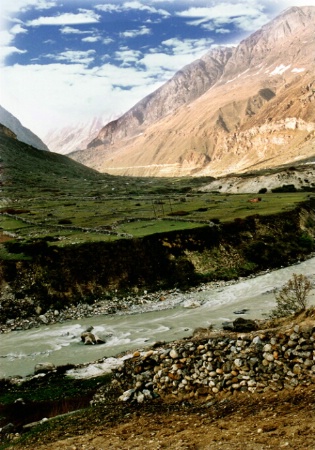
Raman Chawla |
|
How to Accentuate the Blue Sky Over Mountains?
I recently visited a popular hill station in India at an altitude of about 3500 meters. The sky was already deep blue and some of the peaks were snow capped. I had used an automatic SLR camera with circular polarizing and warm up filters screwed on the lens. I was worried that the polarizer would make the sky more deep than what it was, but the results have disappointed me. What I have got is dull and light blue sky instead. The clouds have well defined features though. Will anybody explain to me where I went wrong?
May 22, 2003
|
|
|
doug Nelson |
|
Look at your negatives. Do they look thin, somewhat washed out? If you were shooting slides, do they look very dense? If either applies, you allowed the white peaks and generally bright area of the sky to cause the automated exposure to close down too much, thereby underexposing. The clouds look great, because your exposure was close to correct for them. I've made this mistake (too) many times. You could have taken your light meter reading from the dark blue part of the sky. In a situation like this, use the optional spot meter of your camera, and meter from a mid-tone area. Or, if your camera doesn't have a spot meter, choose a mid tone area, take your meter reading, use AE lock (usually by pressing the shutter button down slightly), then compose your picture while holding the shutter partly down. Additionally, in a tough metering situation like this, shoot a stop over and a stop under, then shoot maybe 1/2 stop over and 1/2 under. Alternatively, try using exposure compensation and metering full frame as you did before. Then set it for + 2 stops, shoot one at + 1 1/2, another at +1. Try it without the polarizer and filter, and again with them. A word of caution: stacking filters will sometimes cause vignetting or darkened corners of your negatives. Go back and try it again, and show us this wonderful place.
May 22, 2003
|
|
|
George E. Givens Jr |
|
|
|
|
|

Don Cesar Hotel, St. Petersburg, Fl.
Believe it or not this was taken with Olympus APS Pic 90 p&s just before noon from the beach shooting north. No polarizer was needed.
George E. Givens Jr
|
|
|
|
You left out too many variables. What kind of film were you using? What type of metering were you using? Why did you use a polarizer if the sky was already blue? Were you position at a 90 degree angle to sun as you should be when using a polarizer? Most times in the northern hemisphere if you shooting north, especially in the A.M., you do not need a polarizer because the sky is arealdy blue. Also, as the previous answer indicated, for important shots always bracket! Here is an example of a shot taken in the northern hemisphere with the camera pointed to north. I did not use a polarizer.
May 25, 2003
|
|
|
Raman Chawla |
|
Thank you Doug and George for your constructive comments. I used Fuji Pro 100 film and my camera used a kind of center-weighted metering. Doug is right. I should have exposed for the dark blue part of the sky because that is what attracted me in the first place. And George is also right because if the sky is already deep blue then why bother with a polarizer at all. his picture tells it so clearly. I am afraid I can not go back to such a lovely place so soon, but I am uploading two of the pictures which I have tried to improve in PS.
May 26, 2003
|
|
|
Raman Chawla |
|
|
|
|
|

Deep blue attracts but disappoints
Raman Chawla
|
|
|
|

Deep blue attracts, but disappoints..
Raman Chawla
|
|
|
|
I am uploading two pics.
May 26, 2003
|
|
|
Charlie F. Kohn |
|
Dear Raman,
In both cases I am not able to see a "deep blue sky". Instead I can see a hazy condition that could have been helped a little by a skylight filter. As to my experience in such cases a polarizer doesn't help much.
The fuji pro 100 is said to be an extremely finely graduated material. Nothing of that quality turns out in your pictures. My questions:
1. Are you sure of the quality of your lab? Was it a pro-lab?
2. How distinctive is the difference between your original slide and the image here? Which scanner do you use and can you check on the settings and try again? Everything else about metering and bracketing has been said and should be normal routine for places and events one cannot repeat or cannot expect to go back to anytime.
May 27, 2003
|
|
|
doug Nelson |
|
Raman,
Both your photos may be an accurate rendering of the scene. The sky in the second one is a bit hazy, anyway. In the first scene, the range of brightness is staggering, maybe more than the film can handle. We can expect to take a loss in the shadows or in the highlights. This is why bracketing is important; you can pick the exposure that you like best.
May 27, 2003
|
|
|
Raman Chawla |
|
Thank you Charlie, thank you Doug. I think bracketing and UV filter would have helped. As regards the lab, I have my doubts. They say I have over-exposed the film.
May 27, 2003
|
|
|
George E. Givens Jr |
|
Raman,
One more thing to try is a "split Neutral Density filter". These filters can bring either the top, bottom, left, or right half of the sceen into a range your film can handle so you won't have to make a decision about whether to lose highlights or shadow detail.I personally like the Cokin filters because they are easy to use and and will fit all your lenses regardless of the diameter. That is because you purchase an adapter ring to fit your lenses and the filter holder goes on the adapter.
May 29, 2003
|
|
|
Raman Chawla |
|
|
|
|
|

Auto exposure at f/22 takes in shadow region
The sky has been replaced by my lab. The original had a washed out sky.
Raman Chawla
|
|
|
|
Thank you, George for suggestions. Since my camera has some kind of built in exposure compensation, I will have to either invest in some filters like UV and Nd or grads or else take pics in the manual mode. Thanks again.
May 30, 2003
|
|
|
Charlie F. Kohn |
|
Well Raman,
now I believe we have come to the point: no automatic exposure can cope with such extreme light situations. The trick will be to use manual mode, use bracketing and experiment with uv and/or nd filters. And, please don't forget to show us the result then. Promise?
Best regards
May 31, 2003
|
|
|
Sreedevi Swaminathan |
|
Another suggestion, What brand of filter? I love my polarizing filter and use it all the time for the exact same purpose. I always want to get a vivid sky. when I see a blue sky, I want it bluer and the clouds to pop. I have a Tiffen polarizer which has never failed me in this attempt. Generally, if it's a sunny day, but still a little hazy, even then, it'll make the sky blue. But this filter can be turned around, Because it's really meant for glares. When you spin it and look through the lens, you can see what it's doing to reflections in a window, but you can also see how light or dark it gets, how much polarizing power it has or not. You want to make sure you have it so it's on the darker side. It never works the other way. Also, I mentioned the brand, because when using a Kodak polarizing filter, I've never gotten any results. I've never been able to make it work to pop colors. And when I look through it I don't see a change in light, slightly in reflections. Try a Tiffen. Why did you use the warming filter with it? If it was already a beautiful sunny day, and you wanted the blue of the sky to pop, I believe the polarizer can accomplish this without any casts, otherwise, perhaps using a warming filter did it, depending on which warming filter it was. yellow is blue's compliment, so it could take blue away. By the way, which hill station? Ooty is absolutely beautiful.
June 03, 2003
|
|
|
Charlie F. Kohn |
|
very well, I never used a kodak pol. my circular polarizer does exactly as sreedevi described, I see what I get by turning, clouds popping and all. but you should consider its density. for low speed films you might end up in the tripod area. but its easy to find out and even easier to get wonderful results with.
good light!charlie.f.kohn@sixpence-pictures.com // madrid
June 03, 2003
|
|
|
Andy |
|
There is the regular polarizer, warm tone polarizer and Singh-Ray Gold+Blue polarizer (about $200). I wish I have one of this gold+blue polarizer.
June 03, 2003
|
|
|
Raman Chawla |
|
Thank you, folks for taking time to input your comments. Well, Sreedevi, I used a cokin polarising filter and I wanted a warming effect so I used a warm-up filter. As for the hill station, well, it was Badrinaath, one of the four most sacred Hindu shrines. I would love to exchange more on mountains' photos. Please e-mail me at rasn@bol.net.in. Thanks.
June 03, 2003
|
|
|
|
Log in to respond or ask your own question.
|